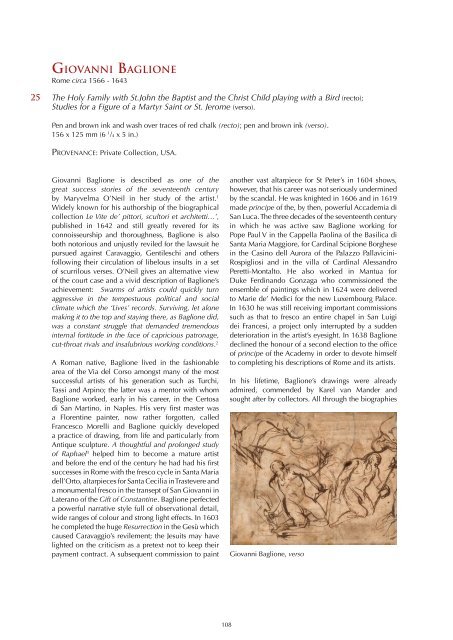Create successful ePaper yourself
Turn your PDF publications into a flip-book with our unique Google optimized e-Paper software.
Giovanni Baglione<br />
Rome circa 1566 - 1643<br />
25<br />
The Holy Family with St.John the Baptist and the Christ Child playing with a Bird (recto);<br />
Studies for a Figure of a Martyr Saint or St. Jerome (verso).<br />
Pen and brown ink and wash over traces of red chalk (recto); pen and brown ink (verso).<br />
156 x 125 mm (6 1 /4 x 5 in.)<br />
Provenance: Private Collection, USA.<br />
Giovanni Baglione is described as one of the<br />
great success stories of the seventeenth century<br />
by Maryvelma O’Neil in her study of the artist. 1<br />
Widely known for his authorship of the biographical<br />
collection Le Vite de’ pittori, scultori et architetti…’,<br />
published in 1642 and still greatly revered for its<br />
connoisseurship and thoroughness, Baglione is also<br />
both notorious and unjustly reviled for the lawsuit he<br />
pursued against Caravaggio, Gentileschi and others<br />
following their circulation of libelous insults in a set<br />
of scurrilous verses. O’Neil gives an alternative view<br />
of the court case and a vivid description of Baglione’s<br />
achievement: Swarms of artists could quickly turn<br />
aggressive in the tempestuous political and social<br />
climate which the ‘Lives’ records. Surviving, let alone<br />
making it to the top and staying there, as Baglione did,<br />
was a constant struggle that demanded tremendous<br />
internal fortitude in the face of capricious patronage,<br />
cut-throat rivals and insalubrious working conditions. 2<br />
A Roman native, Baglione lived in the fashionable<br />
area of the Via del Corso amongst many of the most<br />
successful artists of his generation such as Turchi,<br />
Tassi and Arpino; the latter was a mentor with whom<br />
Baglione worked, early in his career, in the Certosa<br />
di San Martino, in Naples. His very first master was<br />
a Florentine painter, now rather forgotten, called<br />
Francesco Morelli and Baglione quickly developed<br />
a practice of drawing, from life and particularly from<br />
Antique sculpture. A thoughtful and prolonged study<br />
of Raphael 3 helped him to become a mature artist<br />
and before the end of the century he had had his first<br />
successes in Rome with the fresco cycle in Santa Maria<br />
dell’Orto, altarpieces for Santa Cecilia in Trastevere and<br />
a monumental fresco in the transept of San Giovanni in<br />
Laterano of the Gift of Constantine. Baglione perfected<br />
a powerful narrative style full of observational detail,<br />
wide ranges of colour and strong light effects. In 1603<br />
he completed the huge Resurrection in the Gesù which<br />
caused Caravaggio’s revilement; the Jesuits may have<br />
lighted on the criticism as a pretext not to keep their<br />
payment contract. A subsequent commission to paint<br />
another vast altarpiece for St Peter’s in 1604 shows,<br />
however, that his career was not seriously undermined<br />
by the scandal. He was knighted in 1606 and in 1619<br />
made principe of the, by then, powerful Accademia di<br />
San <strong>Luc</strong>a. The three decades of the seventeenth century<br />
in which he was active saw Baglione working for<br />
Pope Paul V in the Cappella Paolina of the Basilica di<br />
Santa Maria Maggiore, for Cardinal Scipione Borghese<br />
in the Casino dell Aurora of the Palazzo Pallavicini-<br />
Rospigliosi and in the villa of Cardinal Alessandro<br />
Peretti-Montalto. He also worked in Mantua for<br />
Duke Ferdinando Gonzaga who commissioned the<br />
ensemble of paintings which in 1624 were delivered<br />
to Marie de’ Medici for the new Luxembourg Palace.<br />
In 1630 he was still receiving important commissions<br />
such as that to fresco an entire chapel in San Luigi<br />
dei Francesi, a project only interrupted by a sudden<br />
deterioration in the artist’s eyesight. In 1638 Baglione<br />
declined the honour of a second election to the office<br />
of principe of the Academy in order to devote himself<br />
to completing his descriptions of Rome and its artists.<br />
In his lifetime, Baglione’s drawings were already<br />
admired, commended by Karel van Mander and<br />
sought after by collectors. All through the biographies<br />
Giovanni Baglione, verso<br />
108
















